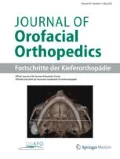Zusammenfassung
Es wird eine Apparatur zur Friktionsmessung zwischen Bracket und Bogen vorgestellt, die Messungen in vitro und in vivo erlaubt. Durch den Vergleich der Friktionskräfte, die entstehen, wenn die Brackets auf menschliche Oberkiefer-Inzisivi oder einen unbeweglichen Kunststoffkörper geklebt sind, werden Rückschlüsse auf die Beeinflussung der Friktion durch die physiologische Zahnbeweglichkeit möglich. Es zeigt sich, daß die gemessenen Reibungskräfte, die an okklusal unbelasteten Zähnen in vivo gemessen werden, sich nich signifikant von den bei geometrisch gleichen Verhältnissen in vitro gemessenen unterscheiden. Allerdings wird nachgewiesen, daß durch willkürliche okklusale Belastung der beklebten Zähne die Friktionskräfte deutlich reduziert werden. Dabei ist zu berücksichtigen, daß die in vivo beklebten Zähne parodontal gesund und fest waren. Es ist deshalb zu erwarten, daß durch die erhöhte Zahnbeweglichkeit im Rahmen einer Multibandbehandlung und zusätzliche Kräfte auf die Bögen beim Essen die bei einer festsitzenden Behandlung auftretenden Friktionskräfte noch geringer sind als hier gemessen.
Summary
This study compared frictional forces which occurred in vivo and in vitro. A testing device was used which allowed reproduction of friction measurements carried out on upper central incisors of volunteers under laboratory conditions with the bracket fixed immovable. By this means changes of friction due to physiological tooth mobility and occlusal load of the bonded teeth could be investigated. While the friction measured in vitro with immovable brackets and in vivo without occlusal load did not differ significantly, additional tooth movement by occlusal load resulted in significant reduction of friction magnitude. It should be kep in mind that the mobility of those teeth investigated was absolutely normal, while it is usually increased during orthodontic treatment. Due to this effect and influences resulting from chewing various kinds of food, it can be estimated that the frictional forces occurring with orthodontic treatment are even smaller in comparison to in vitro experiments with immovable brackets.
Literatur
Andreasen, G. F., T. Quevedo: Evaluation of friction in the 0.022×0.028″ edgewise bracket in vitro. J. Biomechanics 3 (1970), 151–160.
Baker, K. L., L. G. Nieberg, A. D. Welmer, M. Hanna: Frictional changes in force values caused by saliva substitution. Amer. J. Orthodont. dentofac. Orthop. 91 (1987), 316–320.
Buck, T. E., J. E. Scott, W. E. Morrison: A study of the distribution of force in cuspid retraction utilizing a coil spring. Thesis. University of Texas, zit. nach Andreasen, 1963.
Burstone, C. J.: Variable modulus orthodontics. Amer. J. Orthodont. 80 (1981), 1–16.
Burstone, C. J.: The segmented arch approach to space closure. Amer. J. Orthodont. 82 (1982), 361–378.
Drescher, D., C. Bourauel, H.-A. Schumacher: Frictional forces between bracket and arch wire. Amer. J. Orthodont. dentofac. Orthop. 96 (1989), 397–404.
Drescher, D., W. Laaser, H. A. Schumacher: Material-technische Untersuchungen zum Problem der Friktion zwischen Bracket und Bogen. Fortschr. Kieferorthop. 50 (1989), 256–267.
Echols, P. M.: Elastic ligatures: Binding forces and anchorage taxation. Amer. J. Orthodont. 67 (1975), 219–220.
Frank, C. A., R. J. Nikolai: A comparative study of frictional resistances between orthodontic bracket and arch wire. Amer. J. Orthodont. 58 (1980), 593–609.
Garner, L. D., W. W. Allai, B. K. Moore: A comparison of frictional forces during simulated canine retraction of a continuous edgewise arch wire. Amer. J. Orthodont. 90 (1986), 199–203.
Jost-Brinkmann, P.-G., R.-R. Miethke: Versuchsapparatur zur Friktionsmessung zwischen Bracket und Bogen. Posterdemonstration bei der Tagung der Deutschen Gesellschaft für Kieferorthopädie vom 25. 5. bis 28. 5. 1988 in Frankfurt.
Jost-Brinkmann, P.-G., R.-R. Miethke: Versuchsapparatur zur Friktionsmessung zwischen Bracket und Bogen-erste Ergebnisse und Perspektiven. Posterdemonstration auf dem 4. Treffpunkt Medizintechnik am 17. 2. 1989 in Berlin.
Kamiyama, T., T. Sasaki: Friction and widths of brackets. J. Jap. Orthodont. Soc. 32 (1973), 286–289.
Kesling, P. C.: Dynamics of the tip-edge bracket. Amer. J. Orthodont. dentofac. Orthop. 96 (1989), 16–25.
Nikolai, R. J.: Bioengineering analysis of orthodontic mechanics. Lea & Febiger, Philadelphia 1988, p. 53–55.
Peterson, L., R. Spencer, G. Andreasen: A comparison of friction resistance for nitinol and stainless steel wire in edgewise brackets. Quintess. Int. (1982), 563–571.
Riley, J. L., S. G. Garrett, P. C. Moon: Frictional forces of ligated plastic and edgewise brackets. IADR Abstracts 98 (1979).
Sander, G., Fröhls: Zahnbeweglichkeit nach kieferorthopädischer Multibandbehandlung. Inf. Orthodont. Kieferorthop. 21 (1989), 89–102.
Schudy, F. F., G. F. Schudy: The bimetric system. Amer. J. Orthodont. 67 (1975), 57–91.
Sevinc, H.: Der Caninretraktionsbogen — eine neue Version. Fortschr. Kieferorthop. 49 (1988), 529–534.
Schulte, W.: Das Periotestverfahren. Dtsch. Zahnärztekalender (1989), 106–126.
Stoner, M. M.: An analysis of forces currently used in orthodontic practice and a description of new methods of contouring loops to obtain effective control in all three planes of space. Amer. J. Orthodont. 46 (1960), 163–186.
Thurow, R. C.: Elastic ligatures, binding forces, and anchorage taxation. Amer. J. Orthodont. 67 (1975), 694.
Tidy, D. C.: Frictional forces in fixed appliances. Amer. J. Orthodont. dentofac. Orthop. 96 (1989), 249–254.
Ziegler, P., B. Ingervall: A clinical study of maxillary canine retraction with a retraction spring and with sliding mechanics. Amer. J. Orthodont. dentofac. Orthop. 95 (1989), 99–106.
Author information
Authors and Affiliations
Rights and permissions
About this article
Cite this article
Jost-Brinkmann, P., Miethke, R.R. Einfluß der physiologischen Zahnbeweglichkeit auf die Friktion zwischen Bracket und Bogen. Fortschritte der Kieferorthopädie 52, 102–109 (1991). https://doi.org/10.1007/BF02164714
Accepted:
Issue Date:
DOI: https://doi.org/10.1007/BF02164714

